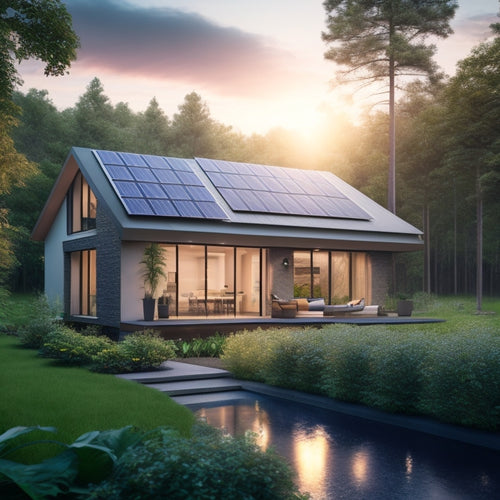
What Are Solar Rain Barrel Pumps: Sustainable Irrigation Solution?
Share
You're looking for an eco-friendly way to irrigate your garden or garden area, and you've come across solar rain barrel pumps. These innovative systems utilize the power of sunlight to pump rainwater, reducing your reliance on municipal water sources and grid energy. By utilizing renewable energy, you'll not only lower your carbon footprint but also save money on your water and energy bills. With a solar rain barrel pump, you'll conserve water, reduce stormwater runoff, and promote sustainable gardening practices. Now that you've got a grip on the basics, you're ready to investigate the specifics of how these systems work and how you can make the most of them.
Key Takeaways
- Solar rain barrel pumps harness solar energy to power irrigation systems, reducing reliance on municipal water and promoting sustainability.
- These pumps convert sunlight into electrical energy, quietly operating in the background to distribute collected rainwater for gardening and agriculture.
- Solar-powered irrigation systems conserve water, reduce stormwater runoff, and decrease municipal demand, aligning with broader environmental goals.
- By utilizing renewable energy, solar rain barrel pumps minimize carbon footprint, reduce operating costs, and enhance property value through tax incentives.
- These eco-friendly pumps provide an energy-independent solution for irrigation, supporting sustainable gardening practices and reducing reliance on grid energy.
How Solar Rain Barrel Pumps Work
You're probably wondering how solar rain barrel pumps manage to capture the sun's energy to pump water from your rain barrel.
It's actually quite simple. These pumps employ solar technology to convert sunlight into electrical energy, which powers a small pump. This pump is connected to your rain barrel and a hose or irrigation system, allowing you to irrigate your garden or lawn sustainably.
By choosing solar power, you're reducing your reliance on the grid and minimizing your carbon footprint, much like achieving energy independence for fleets.
As you soak up the sun, the solar panel generates electricity, and the pump quietly works in the background to distribute water exactly where it's needed.
By capturing the sun's energy, you're not only reducing your carbon footprint but also embracing sustainable gardening practices.
With solar rain barrel pumps, you're free to water your garden without worrying about the environmental impact.
Benefits of Solar-Powered Irrigation Systems
By using a solar-powered irrigation system, you'll be contributing to water conservation efforts, as these systems promote efficient water use and reduce waste.
You'll also gain energy independence, as you'll no longer be reliant on municipal power supplies to irrigate your garden or yard.
Additionally, integrating renewable energy sources into your irrigation system can lower operating costs and enhance energy self-sufficiency.
This independence can lead to significant cost savings and a reduced carbon footprint.
Water Conservation Efforts
This innovative approach to irrigation reduces the strain on municipal water supplies, an essential aspect of water conservation efforts.
By collecting rainwater and using solar power to pump it, you're actively participating in rainwater management and sustainable gardening practices. You'll reduce your reliance on potable water for irrigation, decreasing the demand on municipal supplies.
As fleets shift towards electrification, they can also transition to renewable energy, contributing to a significant reduction in greenhouse gas emissions.
This approach also helps mitigate stormwater runoff, which can carry pollutants into local waterways.
Energy Independence Gained
Solar-powered irrigation systems enable homeowners to break free from reliance on the grid, achieving energy independence that saves money and reduces carbon footprint.
By utilizing renewable resources, you'll no longer be tied to fluctuating energy costs or contribute to greenhouse gas emissions. This means you'll enjoy energy autonomy, relying on your own clean energy source to power your irrigation system.
In addition, investing in renewable energy for charging stations reduces operational costs and enhances property value via tax incentives Government Incentives.
With solar-powered pumps, you'll reduce your reliance on non-renewable energy sources, decreasing your carbon footprint and contributing to a more sustainable future.
You'll also save money on your energy bills, as you generate your own power and reduce your dependence on the grid.
Rainwater Harvesting With Solar Pumps
You're likely aware that rainwater harvesting is an effective way to conserve water, and with solar pumps, you can collect and employ rainwater without relying on electricity.
By integrating solar energy solutions into your irrigation system, you can reduce your carbon footprint and lower your operating costs.
To get the most out of your system, you'll want to optimize your rainwater collection process, ensuring you're capturing every precious drop.
Collecting Rainwater Effectively
Capture rainwater efficiently by directing it from your rooftop to a storage tank, where a solar rain barrel pump can then employ the collected water for various non-potable purposes. Effective storage is key to maximizing rainwater collection. Consider the following factors to optimize your rainwater collection system:
| Roof Size | Average Rainfall | Storage Capacity |
|---|---|---|
| 1,000 sqft | 1 inch/month | 600 gallons |
| 2,000 sqft | 2 inches/month | 1,200 gallons |
| 3,000 sqft | 3 inches/month | 1,800 gallons |
Pumping Without Electricity
With your storage tank full of collected rainwater, it's time to contemplate how to distribute it efficiently to your desired applications.
You've got a few options for pumping without electricity. Gravity fed systems are a great choice, relying on the natural flow of water to supply your irrigation needs. However, this method is limited by the height of your storage tank and the distance to your application.
Manual pumping is another option, using a hand-operated pump to transfer water from your tank. While effective, this method can be labor-intensive and time-consuming.
Solar-powered pumps offer a convenient and energy-independent solution, allowing you to effortlessly distribute rainwater to your garden, lawn, or other applications.
Choosing the Right Solar Pump Size
When selecting a solar rain barrel pump, sizing is essential to confirm efficient water distribution.
You'll need to take into account your specific irrigation needs, considering the distance and elevation change between the pump and the areas you want to water.
Calculate your pump capacity by determining the total gallons per minute (GPM) required for your irrigation system.
Look for a pump with a flow rate that matches your calculated GPM.
Additionally, evaluate the maximum lift head, which is the highest vertical distance the pump can push water.
Verify the pump you choose can handle the lift head required for your system.
Installing a Solar Rain Barrel Pump
Beyond the selection process, you're now ready to install your solar rain barrel pump, an essential step in utilizing the power of solar energy for your irrigation needs.
Proper installation techniques are critical for peak performance. Begin by positioning the pump near the rain barrel, confirming it's level and secure.
Connect the intake hose to the pump and submerge the other end into the barrel, avoiding any debris or sediment.
Next, connect the outlet hose to the pump and direct it to your irrigation system.
Finally, mount the solar panel in a spot that receives direct sunlight, ideally at an angle to maximize energy absorption.
Proper pump positioning and installation will guarantee efficient water flow and minimize energy loss.
Maintenance and Troubleshooting Tips
Now that your solar rain barrel pump is up and running, it's time to focus on maintaining its performance and troubleshooting any issues that may arise.
To guarantee peak pump maintenance, regularly inspect the system for signs of wear and tear, clean the filters, and check the battery's state of charge.
Perform routine water testing to detect any potential contamination.
When troubleshooting, start by checking the power source and pump connections.
Use troubleshooting techniques like process of elimination to identify the root cause of the issue.
Refer to the user manual or manufacturer's guidelines for specific guidance on resolving common problems.
Frequently Asked Questions
Can I Use a Solar Rain Barrel Pump for Household Water Supply?
As you crave independence from the grid, you wonder if a solar rain barrel pump can quench your household's thirst. While it's possible, you'll need to guarantee the system meets your daily water needs, prioritizing water conservation and energy efficiency for a sustainable freedom.
Are Solar Rain Barrel Pumps Suitable for Large-Scale Agricultural Use?
You're considering solar rain barrel pumps for large-scale agricultural use, but you'll need to weigh efficiency concerns against the benefits of renewable energy. Conduct a thorough cost analysis to determine if the investment is viable for your operation.
Do Solar Pumps Require a Battery Backup for Nighttime Use?
You don't necessarily need a battery backup for nighttime use, as solar pumps utilize energy during the day, but investing in one guarantees continuous operation and peak solar energy efficiency, plus reduces pump maintenance tips like frequent restarts.
Can I Connect Multiple Rain Barrels to a Single Solar Pump?
Can you imagine having a network of rain barrels working together in harmony? You can connect multiple rain barrels to a single solar pump, ensuring efficient water distribution while minimizing rain barrel maintenance and maximizing solar pump efficiency.
Are Solar Rain Barrel Pumps Compatible With Existing Irrigation Systems?
When integrating a solar rain barrel pump into your existing irrigation system, you'll want to follow installation tips and maintenance best practices to guarantee seamless compatibility, allowing you to harvest rainwater freely and efficiently.
Related Posts
-

3 Best Eco-Grants for Home Energy Upgrades
You're eligible for various eco-grants that can help you cut down on energy bills and reduce your carbon footprint by...
-

7 Solar-Safe Window Solutions for Earth-Conscious Homeowners
As an earth-conscious homeowner, you're likely keen to find solar-safe window solutions that align with your values. ...
-

Why EVs Inspire Earth-Conscious Home Design Choices
As you shift to an electric vehicle, you're not just switching to a greener ride, you're igniting a broader commitmen...


